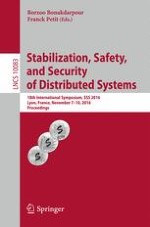2016 | OriginalPaper | Chapter
Self-stabilizing Byzantine Clock Synchronization with Optimal Precision
Authors : Pankaj Khanchandani, Christoph Lenzen
Published in: Stabilization, Safety, and Security of Distributed Systems
Publisher: Springer International Publishing
Activate our intelligent search to find suitable subject content or patents.
Select sections of text to find matching patents with Artificial Intelligence. powered by
Select sections of text to find additional relevant content using AI-assisted search. powered by
